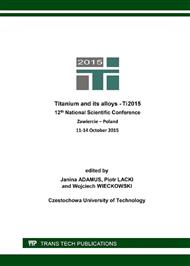p.3
p.11
p.19
p.25
p.33
p.41
p.47
p.55
Microstructure and Interconnections Characteristics of Titanium Foam
Abstract:
Titanium foams are widely used as biomaterials and potentially as a twin skinned, sandwich, structures for aerospace structures, filter or a catalyst or catalysts carrier for chemical reactions. The porosity is particularly important for tissues ingrowth and vascularity. Open porosity is essential in the case of flow-on machines. The distribution and size of pores is significant to achieve a uniform material effort and ensure to receive an appropriate hydraulic properties.The aim of this study was to determine the effect of titanium particle size and the amount of porogen on the microstructure and the size of pore interconnections in titanium foams made using saccharose as the space holder material.The paper characterizes titanium foam, made from the Grade 1 Ti powders (Alfa Aesar) with a particle sizes of 0.150 mm and 0.044 mm (separately) and spherical particles of saccharose (Pfeifer & Langen) having an average size of 0.7 ÷ 0.9 mm, as a porogen. There was prepared a mixture of powders of the proposed porosity of 50, 60 and 70%. Summarizing 6 mixtures were prepared. After sintering there were received specimens having a diameter of 8 mm and a height of 5 mm. Microstructure analysis was performed using the microtomography Skyscan 1172 (Bruker microCT) and the CTAn software (Bruker microCT).The results indicate the uniform pore distribution and size of the interconnections allowing high permeability.
Info:
Periodical:
Pages:
25-32
Citation:
Online since:
April 2016
Authors:
Price:
Сopyright:
© 2016 Trans Tech Publications Ltd. All Rights Reserved
Share:
Citation:


